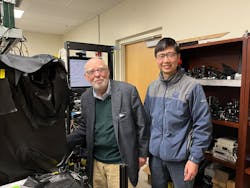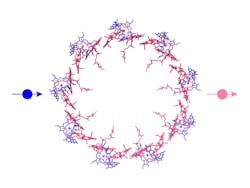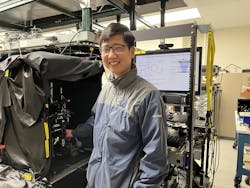A team of scientists from the University of California, Berkeley, and Lawrence Berkeley National Laboratory (LBNL) recently ran experiments using quantum light spectroscopy to explore whether a single photon can initiate the first step of photosynthesis in purple bacterium Rhodobacter sphaeroides.
It turns out a single photon is indeed all it takes to initiate photosynthesis—and since all photosynthetic organisms share an evolutionary ancestor and use similar processes, the scientists believe photosynthesis in plants and algae is also triggered by a single photon (see video).
The combined groups of Graham Fleming, a senior faculty scientist in biosciences for LBNL and professor of chemistry at UC Berkeley, and Birgitta Whaley, a professor of chemical physics at UC Berkeley and a senior faculty scientist in energy sciences for LBNL, were inspired by the realization that the sun on the scale of a chlorophyll molecule is a very weak light source and classical ideas about the initial absorption of energy to kick off photosynthesis would not be adequate.
A lot of the previous work with photosynthesis involved triggering photosynthetic molecules with powerful ultrafast lasers, but there’s a huge difference in intensity between a laser and sunlight—a laser beam is a million times brighter.
While a tremendous amount of work has been done both experimentally and theoretically to explore what happens after light is absorbed, “very little has been done exploring the initial step of absorbing light,” Fleming says. “So we decided to use a quantum light source to study this initial step.”
Zeroing in on single photons
Photosynthesis has been studied for centuries, but “many important questions remain open regarding the microscopic mechanism,” points out Quanwei Li, a postdoc researcher on the team working with both Fleming and Whaley, who specializes in developing new experimental techniques with quantum light. “For example, how exactly does the energy from sunlight get absorbed in the first place and how does this absorbed energy flow so efficiently to the reaction center to drive chemical reactions?”
Sunlight is a weak source, so a fundamental description of light absorption and energy flow must involve quantum optics, which describes the quantum state of light in terms of photons—individual undividable particles of light—and the quantum theory of how photons interact with atoms/molecules. “But there’s a gap between quantum optics/physics and photosynthesis/biology, as you can imagine,” Li says.
For their first round of experiments, the scientists set up a photon source to generate a single pair of photons through a parametric down-conversion process. During each pulse, the first photon, “the herald,” is observed with a highly sensitive detector to confirm the second photon is on its way to an assembled sample of light-absorbing molecular structures taken from photosynthetic bacteria. And another photon detector near the sample measures the lower-energy photon that gets emitted by the photosynthetic structure after it absorbs the second “heralded” photon of the original pair.
The team chose to send in only a single photon at a time to see what would happen (see Fig. 1). “In our setup, we first generate a heralded single photon,” Li explains. “Next, we send this single photon to light harvesting 2 (LH2) complexes isolated from purple bacterium Rhodobacter sphaeroides. Then, we look for and detect any red-shifted fluorescent emission from LH2 after the input single photon is absorbed and its energy flows around inside LH2.”
Photons at the 800 nm wavelength get absorbed by a ring of nine bacteriochlorophyll molecules in LH2, which sends energy to a second ring of 18 bacteriochlorophyll molecules that can emit fluorescent photons at 850 nm within the native bacteria. This means the energy from the photons continues to be transferred to subsequent molecules until it’s used to trigger the chemistry of photosynthesis. But for the team’s experiment, when LH2s were separated from other cellular machinery, the detection of the 850 nm photon served as a definitive sign the process was activated.
The scientists say they studied more than 17.7 billion herald photon detection events and 1.6 million heralded fluorescent photon detection events to ensure their observations could only be attributed to single-photon absorption, and no other factors were influencing their results.
Li notes that for this first round of experiments, they don’t have the dynamic information about how the energy flows inside LH2. Essentially, the team only knows the input and output are single photons.
Several a-ha! moments along the way
The coolest aspect of this work is that “we successfully carried out strict quantum optic experiments with a complex biological system with a single photon to begin with, given it’s very easy to lose a single photon without any signal,” says Li.
Their first ‘a-ha’ moment occurred once they had carefully designed the setup and estimated the signal, then discovered it was actually a feasible experiment.
A second ‘a-ha’ moment hit when they first detected the fluorescent signal, and the third was when they succeeded in measuring the quantum photon statistics (quantum properties of light) of the fluorescent signal to prove it was a single photon.
“Mother Nature is very clever to ‘design/evolve’ the photosynthetic systems to efficiently make use of every single bit/quantum of energy contained within individual single photons,” says Li. “We humans still have a lot to learn and understand to potentially make use of these ‘design’ principles for advanced technologies, such as to improve crop yield and design more efficient energy devices.”
New era of quantum light spectroscopy
This is merely the beginning because the team’s work showcases the capability of the new tool/technique they’ve named “quantum light spectroscopy” and are currently developing (see Fig. 2).
“It opens up plenty of opportunities to study quantum dynamics in complex systems such as photosynthesis within a new quantum domain,” says Li. “For example, we’d like to extend the technique to explore quantum coherence in photosynthetic systems and defeat the Fourier limit on simultaneous high time and spectral resolution in studying complex systems.”
The team’s discovery and new quantum light spectroscopy tool will help further explore how life behaves at the intersection of quantum physics and biology.
EDITOR’S NOTE
Quanwei Li will give a webinar on the team’s quantum light spectroscopy work on August 19, 2023, at 2 p.m. ET; register at www.laserfocusworld.com/14296000.
FURTHER READING
Q. Li et al., Nature (2023); https://doi.org/10.1038/s41586-023-06121-5.

Sally Cole Johnson | Editor in Chief
Sally Cole Johnson, Laser Focus World’s editor in chief, is a science and technology journalist who specializes in physics and semiconductors. She wrote for the American Institute of Physics for more than 15 years, complexity for the Santa Fe Institute, and theoretical physics and neuroscience for the Kavli Foundation.


